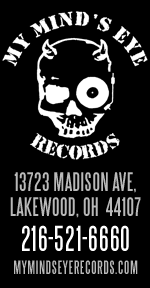 As a teen in the mid-90’s, I got hooked on records early. A membership to the Pearl Jam fan club in 1993 or ’94 allowed me to get my first record. It was a 7″ 45 rpm single for their non-album cut “Angel.” But this post isn’t about that record, that’s just the beginning of my story. Early forays into my record collecting led me from those major-label grunge bands to Sonic Youth, who led me to the Lollapalooza tour they played in 1995. I went to that show with my dad in an old Econoline van that almost broke down on the way there, but left with a stack of catalogs. Do you remember catalogs? The ones I received were mostly all very similar: Records, CD’s, T-Shirts… everything a budding music fan would want to page through over and over again on lazy afternoons. This was my main source for everything music related.
As a teen in the mid-90’s, I got hooked on records early. A membership to the Pearl Jam fan club in 1993 or ’94 allowed me to get my first record. It was a 7″ 45 rpm single for their non-album cut “Angel.” But this post isn’t about that record, that’s just the beginning of my story. Early forays into my record collecting led me from those major-label grunge bands to Sonic Youth, who led me to the Lollapalooza tour they played in 1995. I went to that show with my dad in an old Econoline van that almost broke down on the way there, but left with a stack of catalogs. Do you remember catalogs? The ones I received were mostly all very similar: Records, CD’s, T-Shirts… everything a budding music fan would want to page through over and over again on lazy afternoons. This was my main source for everything music related.
Through all of this catalog reading, I got into fanzines. Through fanzines (and a certain passage of time), I got into internet newsgroups. I read constantly about bands, tours, rock ‘n roll lore, and records. One record in particular that really caught my eye was the RRR-100 7″. I’m sure I found out about it because Sonic Youth cohorts Jim O’Rourke and Merzbow were on the release, but it wasn’t so much the personnel involved that intrigued me, it was the nature of the release. This particular 7″ had 100 individual tracks on it, quite the feat for a medium that maxes out around ten minutes total. This was achieved by each artist only getting one revolution on the record, a locked groove. Of course, I couldn’t ever find this record, but I read all about it.
As it turns out, the record was cut by Aardvark Mastering, a name I kept in mind for several years to come. When it came time to put out a split 7″ between myself and a friend’s band, I sent the masters off to Aardvark because it seemed that they were the only logical choice, being the only ones daring enough to do such a release as a 7″ of only locked grooves. Our 7″ didn’t demand a whole lot of the mastering engineer, it was desperately lo-fi and well within all the time restraints of the medium. I think the only tough-ish request we had were a few custom etchings we wanted in the deadwax, something I thought was unique at the time, but it turns out it really isn’t.
All of this lore came full circle a few months ago. I was flipping through the singles section at a local used bookstore. I go to this particular place because they have a surprisingly decent selection of 80’s pop music, something places with vinyl don’t always have a ton of. Either they’re too indie or too 60’s and 70’s oriented. Either way, I was extremely surprised to find a first pressing copy of the RRR-100 7″ amongst all the Phil Collins and Simple Minds singles. I took it home and tried to play each track, going along with the absurd tracklisting trying to figure out who was who. I lost my place about 20 grooves in on each side. It makes me wonder how tough it must be to navigate through some of RRRecords‘ more recent locked groove compilations. The RRR-500 and RRR-1000 compilations are 12″ LPs that contain 500 and 1000 locked grooves, respectively. The experience of paging through this release in particular (and my history with it) really defined what can be fun about the vinyl medium, and how after seventeen years of collecting, it can still be as fun as playing that first single.









